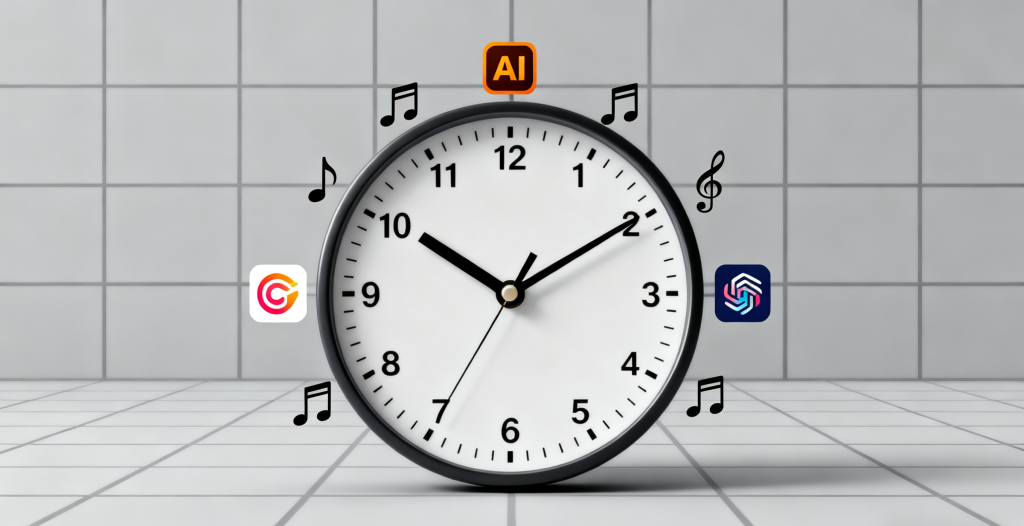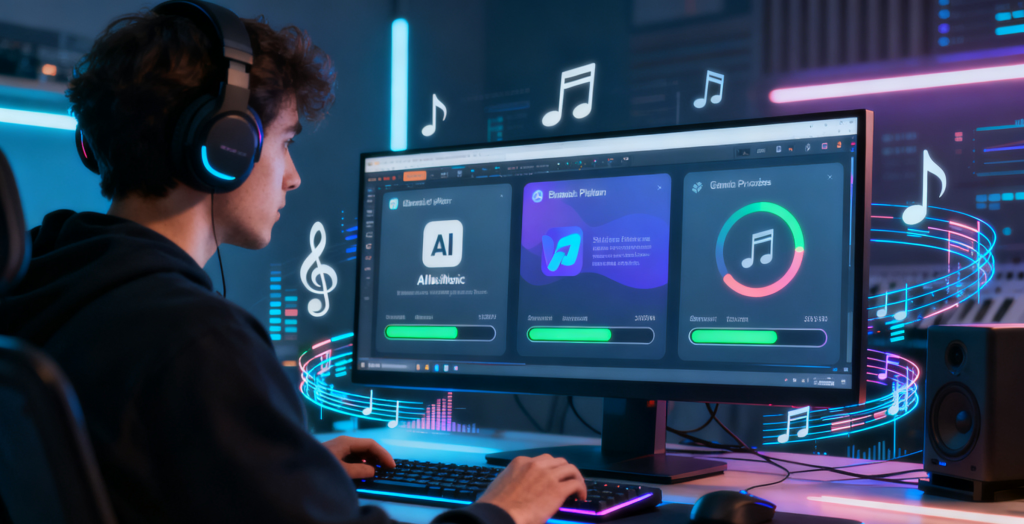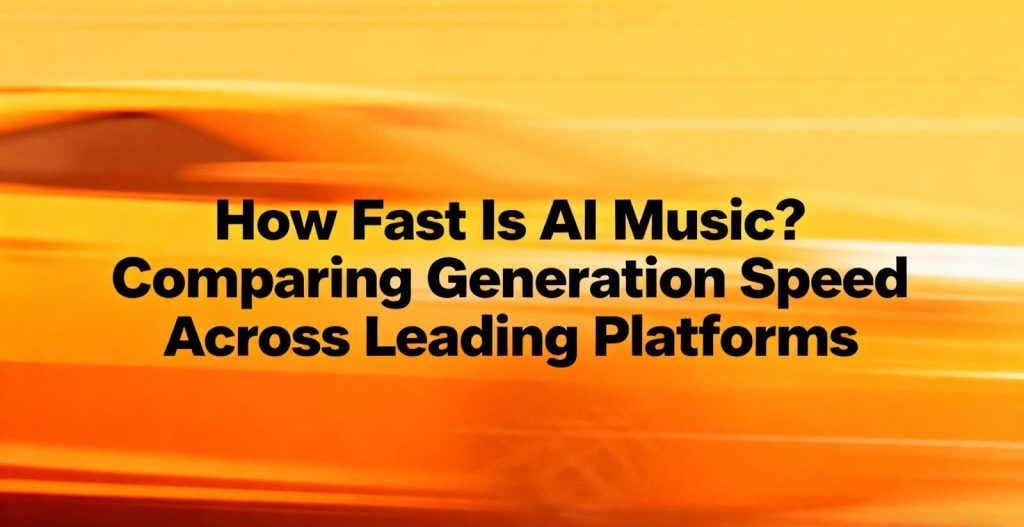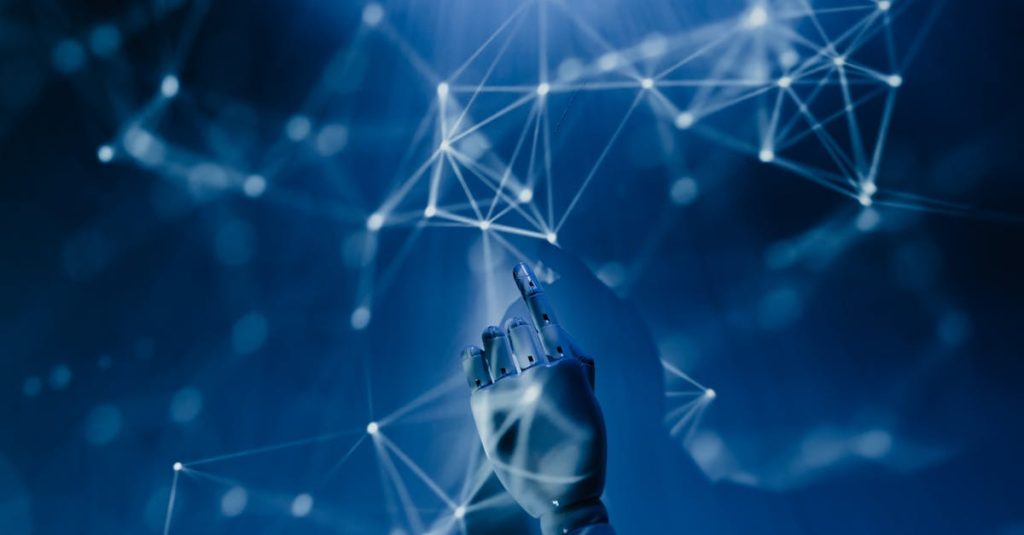AI music generation speed defines how quickly creators can turn ideas into finished tracks and shapes the modern production workflow. Musicians, content creators, producers, hobbyists, and tech enthusiasts increasingly demand instant results to meet tight deadlines and fuel inspiration. This article examines why rapid AI music creation matters, how to measure generation speed, and what leading platforms deliver in 2025. It highlights Mureka’s instrumental AI music generator and integrated editor as a swift solution without interrupting creative flow, then compares key competitors like Loudly, Suno AI, and Mubert. We will explore technical factors that influence processing time, look ahead to low-latency innovations, and address common concerns that arise when speed meets quality. By mapping metrics, benchmarks, and practical use cases, this guide empowers creators to choose the fastest AI music tools suited to their workflow.
Why Does AI Music Generation Speed Matter for Musicians and Content Creators?
Fast AI music generation speed accelerates creative ideation by minimizing the wait time between concept and output. Musicians can experiment with melodies in seconds, while video producers rapidly source background scores for social media clips. This immediacy reduces creative friction and keeps momentum high, making tight project timelines more manageable. Moreover, when AI delivers tracks instantly, hobbyists receive near-real-time feedback on their prompts, promoting iterative refinement without losing inspiration. Understanding this benefit clarifies why speed has become a core performance indicator for modern AI music platforms and leads naturally into examining workflow improvements in depth.
Reducing turnaround time by even a few seconds transforms how teams collaborate and plan. Producers can test multiple stems in quick succession, and content creators can generate thematic variations during live streams or brainstorming sessions. Fast generation also lowers production costs by streamlining studio sessions and avoiding lengthy render queues. These savings in time and resources sharpen competitive advantage, prompting platforms to optimize model inference and latency. In the next section, we will explore how rapid creation translates into tangible enhancements across creative workflows.
How Does Fast AI Music Creation Improve Creative Workflows?
Rapid AI music creation enhances workflow efficiency by enabling continuous experimentation. When musicians generate a melody in under 30 seconds, they can immediately layer harmonies or adjust tempo, fostering a dynamic iterative process. This seamless loop of creation and review shortens project cycles and unlocks spontaneous inspiration moments. As a result, teams spend less time on mechanical tasks and more on refining musical ideas.
What Time Savings Can Producers and Hobbyists Expect from AI Music Speed?
Producers and hobbyists typically save up to 50 percent of their production time when using fast AI tools. For example, generating a basic instrumental track in 30 seconds versus manually composing it in 15–20 minutes multiplies creative throughput. This efficiency allows both professionals and enthusiasts to explore more ideas within the same timeframe, boosting output volume and artistic diversity.
Which Use Cases Rely Most on Rapid AI Music Generation?
Rapid AI music generation proves critical for social media content, podcast intros, game prototyping, and live performance backing tracks. Quick background scores maintain viewer engagement on short-form videos, while game developers iterate audio assets faster during playtesting. Similarly, podcasters can produce theme music on demand, and live performers integrate fresh loops seamlessly into sets. These scenarios illustrate speed’s pivotal role in modern multimedia production.
What Are the Key Metrics to Understand AI Music Generation Speed?
AI music generation speed is measured through metrics like generation time, latency, and inference speed, each quantifying a different stage of processing. Generation time refers to the total duration from user prompt to final audio output, while latency denotes the delay before the system begins producing sound. Inference speed indicates how quickly the underlying model computes new samples. Clarifying these definitions ensures creators set realistic expectations when comparing platforms and helps align tool selection with project requirements.
Beyond raw time measurements, creators often consider throughput and responsiveness under varying loads. Throughput measures how many tracks a system can produce within a given timeframe, highlighting performance under batch conditions. Responsiveness reflects user experience during interactive editing, where near-instant feedback is essential. Evaluating platforms against all these metrics provides a comprehensive view of speed and ensures that fast generation translates into seamless creative interactions.
How Is Generation Time Measured in AI Music Platforms?
Generation time in AI music platforms is the interval between submitting a prompt and receiving the complete audio file. It is typically measured in seconds or minutes and depends on model complexity, server processing power, and track length. Precise measurement often involves timestamping request submission and audio delivery, enabling consistent benchmarking across services.
What Do Latency and Inference Speed Mean for AI Music Creation?
Latency refers to the initial delay before audio output begins after a user’s prompt, while inference speed quantifies how rapidly the AI model computes each subsequent audio frame. Lower latency creates the illusion of real-time performance, whereas higher inference speed ensures continuous generation without glitches. Together, these metrics determine how responsive a platform feels during interactive sessions.How Does Real-Time Generation Affect User Experience?
Real-time generation transforms user experience by providing immediate audio feedback as creators adjust parameters or prompts. This dynamic interaction resembles playing an instrument rather than waiting for a batch render, fostering a more engaging and intuitive creative process. Platforms that achieve sub-second latency deliver the most fluid user experience, particularly important for live performance and improvisation contexts.
How Does Mureka Deliver Fast AI Music Creation for Instrumental Tracks?

Mureka’s instrumental AI music generator combines optimized transformer models with specialized audio codecs to achieve generation speeds around 30 seconds per track. Its AI pipeline leverages lightweight inference engines designed for rapid mel-spectrogram synthesis, reducing compute overhead without sacrificing musical quality. This technology stack empowers content creators to produce high-quality instrumentals in under a minute, positioning Mureka as a fast, reliable solution.
Beyond raw speed, Mureka integrates a streamlined music editor that allows immediate customization without re-rendering entire tracks. Users can adjust arrangement, mix levels, and apply effects on the fly, further accelerating the creative workflow. This combination of fast generation and real-time editing ensures that the transition from AI output to polished production happens within a single interface. Understanding Mureka’s technology highlights how architecture choices directly impact both speed and flexibility.
What Technologies Enable Mureka’s Rapid Music Generation?
Mureka relies on optimized transformer networks trained on diverse instrumental datasets and employs fast Fourier transform-based synthesis to accelerate audio rendering. Custom inference kernels reduce memory bottlenecks, while GPU-accelerated parallel processing shortens compute time per sample. These elements work together to deliver audio outputs in seconds rather than minutes.
How Does Mureka’s Music Editor Enhance Speed and Customization?
Mureka’s music editor offers instantaneous parameter tweaking and stem separation within the same environment, preventing full track regeneration. Users can modify instrument voicings, tempo, and effects in real time, which eliminates waiting periods and maintains creative flow. This tight integration amplifies overall speed by combining generation and editing into one seamless experience.
What Generation Speeds Does Mureka Achieve Compared to Competitors?
| Platform | Generation Time | Key Feature |
|---|---|---|
| Mureka | ~30 seconds | Instrumental tracks with on-the-fly editing |
| Loudly | <5 seconds | Instant royalty-free music |
| Suno AI | <60 seconds | Full song generation with vocals |
| Mubert | ~60 seconds | Continuous loop synthesis |
Which AI Music Platforms Are the Fastest? 2025 Speed Comparison of Leading Generators
Fastest AI music platforms distinguish themselves by minimizing generation time without compromising audio fidelity. Some services achieve sub-5-second outputs for short loops, while others focus on richer arrangements that take up to a minute. Performance depends on model architecture, server infrastructure, and output complexity. Recognizing these trade-offs helps creators align platform choice with project scope and resource constraints.
While raw speed appeals to quick demos, overall value emerges from combining speed with quality and customization. The fastest platforms excel at simple tracks, but systems like Mureka that integrate editing tools deliver greater flexibility for complex productions. This interplay between speed and utility defines the current landscape and informs where each service stands among its peers.
How Fast Are Top Platforms Like Loudly, Suno AI, and Mubert?
Loudly leads with loop generation in under 5 seconds, focusing on short segments and stems. Suno AI produces full songs, including vocal layers, within a minute by leveraging optimized diffusion models. Mubert generates continuous audio streams of 60 seconds or more, aiming for seamless background textures. Each approach targets different use cases, from instant social media soundtracks to extended background compositions.
What Features Affect Speed Across Different AI Music Generators?
- Model Complexity and Size – Larger networks yield higher fidelity but increase compute time.
- Output Length and Layer Count – More instruments or vocals lengthen processing.
- Server Infrastructure and Hardware – GPU-powered clusters accelerate inference.
- Optimization of Inference Kernels – Custom code paths reduce latency.
Where Does Mureka Rank Among Fastest AI Music Generators?
| Platform | 2025 Speed Rank | Avg. Generation Time |
|---|---|---|
| Loudly | 1 | <5 seconds |
| Mureka | 2 | ~30 seconds |
| Suno AI | 3 | <60 seconds |
| Mubert | 4 | <60 seconds |
What Factors Influence AI Music Generation Speed Across Platforms?
AI music generation speed depends on multiple intertwined factors that range from algorithmic design to infrastructure. Model complexity defines the number of computations per audio frame, with deeper networks requiring more processing time. Hardware capabilities determine how quickly these computations occur, especially when GPU acceleration is available. Together, these elements set the baseline for how fast a system can generate music.
How Do Model Complexity and Hardware Impact Generation Time?

Model complexity and hardware determine the computational workload and throughput rate during generation. Larger transformer models produce more nuanced audio but increase inference cycles. High-performance GPUs shorten these cycles by parallelizing matrix operations, reducing overall generation time.
Why Does Prompt Complexity and Output Length Affect Speed?
Longer prompts and extended output durations require processing more data, which leads to proportional increases in compute time. Each additional instrument layer or style modifier adds inference steps, so concise prompts and moderate lengths deliver faster results.
How Does Cloud Infrastructure and Software Design Affect Latency?
Latency is influenced by server location, network routing, and container efficiency. Well-orchestrated microservices and edge deployments minimize round-trip delays, while centralized clusters in distant data centers can add seconds of overhead before audio generation begins.
What Are the Future Trends in AI Music Generation Speed and Quality?
Advancements in low-latency models will push AI music generation toward real-time composition, enabling live improvisation and on-the-fly scoring in performances. Researchers focus on streamable neural architectures that produce audio frames incrementally with sub-100-millisecond latency. These breakthroughs promise to blur the line between human and machine collaboration in music creation.
Market demands for personalized, royalty-free soundtracks and AI-driven post-production tools are driving continuous improvements in both speed and quality. Platform providers invest in optimized inference pipelines and hybrid on-device/cloud solutions to satisfy tight delivery windows and data privacy concerns. Ethical considerations around AI transparency and licensing algorithms will also shape how quickly new features can be rolled out without sacrificing trust and compliance.
How Will Low-Latency and Real-Time Models Change AI Music Creation?
Low-latency and real-time models will enable creators to interact with AI as if playing a musical instrument, adjusting style parameters during live sessions. This interactivity will foster new performance paradigms where AI responds instantly to artistic input, opening avenues for improvisation and collaborative live shows.
What Market Trends Are Driving Faster AI Music Platforms in 2025 and Beyond?
- Demand for Short-form Content – Brands and creators need rapid audio for social platforms.
- Integration with Live Streaming – Real-time background tracks enhance viewer engagement.
- Edge Computing Adoption – On-device processing reduces network latency.
- Subscription-based APIs – Developers embed fast generation into apps and games.
How Is Ethical AI Influencing Speed and Quality in Music Generation?
Ethical AI frameworks prioritize transparency in training data and licensing, which can add processing overhead for content filtering. Balancing fast generation with compliance checks ensures that AI-generated music respects copyright and usage rights. Innovations in on-chip verification will help platforms maintain both speed and ethical standards.
What Are the Most Common Questions About AI Music Generation Speed?
Creators often seek clarity on baseline generation times, the fastest available platforms, and the technical factors that influence performance. They wonder how AI models achieve sub-minute outputs and what trade-offs exist between speed and audio fidelity. Questions about maximizing efficiency and integrating AI tools seamlessly into existing workflows also surface regularly. Addressing these inquiries helps demystify AI music generation and guides users toward solutions that align with their time constraints and quality expectations.
How Long Does It Typically Take to Generate Music Using AI Technology?
AI music generation typically takes between 30 seconds and 2 minutes for a complete track. Basic loops and short stems can appear in under 10 seconds on optimized platforms, while full songs with multiple layers may require up to 120 seconds. Generation speed hinges on prompt complexity, model size, and server performance.
Which AI Music Generator Is the Fastest in 2025?

In 2025, Loudly leads in pure speed, producing short loops in under 5 seconds. Platforms like Mureka follow with full instrumental tracks in roughly 30 seconds. Services that generate complete vocal compositions in under 60 seconds offer a middle ground between speed and complexity.
What Factors Most Affect AI Music Generation Speed?
Key factors include model architecture complexity, hardware acceleration, prompt richness, and output duration. Cloud infrastructure design and network latency also influence end-to-end generation time. Optimizing each element reduces wait times without compromising audio quality.
How Can Content Creators Maximize Efficiency Using Fast AI Music Tools?
To maximize efficiency, keep prompts concise, target moderate track lengths, and choose platforms with integrated editing features to avoid repeated full-track regenerations. Scheduling generation tasks during off-peak hours on high-performance servers can further reduce latency, ensuring a smooth creative process.
AI music generation speed has become a defining performance metric for creative workflows, influencing everything from idea exploration to final edits. By understanding the technical metrics, comparing leading platforms, and leveraging tools like Mureka’s fast instrumental generator and its editor, creators can optimize their production pipelines. As low-latency models and edge computing continue to evolve, the boundary between human creativity and AI assistance will blur further, empowering musicians and content creators to produce high-quality audio faster than ever before.



